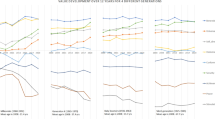Abstract
Three-hundred-and-eighty-one participants (undergraduates, their parents and grandparents) completed body image (BI; current minus ideal figure ratings) and dieting attitude measures. We found the usual gender gap in BI for the undergraduates (females’ BI worse than males’), but not for the parents and grandparents. This was due to males’ worsening BI with age; females’ BI did not differ across generations. The gender gap in dieting attitudes (females more likely to diet) also narrowed with increasing age (again due to males’ changing attitudes), but remained significant across generations. In all three generations, females underestimated the size of the figure males found most attractive, whereas males overestimated the analogous figure for females. Finally, we found significant inter-family correlations for BI and dieting for all groups except undergraduate females. We discuss these results within cultural and evolutionary theoretical frameworks.
Similar content being viewed by others
References
Fallon A.E., Rozin P.: Sex differences in perceptions of desirable body shape. J. Abnorm. Psychol, 94, 102–105, 1985.
Rozin P., Fallon A.: Body image, attitudes to weight, and misperceptions of figure preferences of the opposite sex: A comparison of men and women in two generations. J. Abnorm. Psychol., 97, 342–343, 1988.
Akande A.: Sex differences in preferences for ideal female body shape. Health Care Women Int., 14, 249–259, 1993.
Tiggeman M., Wilson-Barrett E.: Children’s figure ratings: Relationship to self-esteem and negative stereotyping. Int. J. Eat. Disord., 23, 83–88, 1998.
Lamb C.S., Jackson L.A., Cassiday P.B., Priest D.J.: Body figure preferences of men and women: A comparison of two generations. Sex Roles, 28, 345–358, 1993.
Buss D.M., Schmitt D.P.: Sexual strategies theory: An evolutionary perspective on human mating. Psychol. Rev., 100, 204–232, 1993.
Singh D., Young R.K.: Body weight, wait-to-hip ratio, breasts, and hips: Role in judgments of female attractiveness and desirability for relationships. Ethology and Sociobiology, 16, 483–507, 1995.
Garner D.M., Garfinkel P.E., Schwartz D., Thompson M.: Cultural expectations of thinness in women. Psychol. Rep., 47, 483–491, 1980.
Wiseman C.V., Gray J.L., Mosimann J.E., Ahrens A.H.: Cultural expectations of thinness in women: An update. Int. J. Eat. Disord., 11, 85–89, 1992.
American Psychological Association: Diagnostic and Statistical Manual of Mental Disorders: DSM-IV. Washington, DC, American Psychological Association, 1994.
Feingold A., Mazzella R.: Gender differences in body image are increasing. Psychol. Sci., 9, 190–195, 1998.
Rozin P., Trachtenberg S., Cohen A.B.: Stability of body image and body image dissatisfaction in American college students over about 15 years. Appetite, 37, 235–238, 2001.
Karwautz A., Rabe-Hesketh S., Hu X., Zhao J., Sham P., Collier D.A., Treasure J.L.: Individual-specific risk factors for anorexia nervosa: A pilot study using a discordant sister-pair design. Psychol. Med., 31, 317–329, 2001.
Allison D.B., Faith M.S.: Issues in mapping genes for eating disorders. Psychopharmacol. Bull., 33, 359–369, 1997.
Berrettini W.: Genetic aspects of anorexia nervosa and bulimia nervosa. In: Flach F. (Ed.), The Hatherleigh guide to psychiatric disorders, part II. The Hatherleigh guides series. New York, Hatherleigh Company, Ltd., 2000, pp. 89–95.
Stunkard A.J., Sorenson T., Schlusinger F.: Use of the Danish adoption register for the study of obesity and thinness. In: Kety S. (Ed.), The genetics of neurological and psychiatric disorders. New York, Raven Press, 1980, pp. 115–120.
Gardner R.M., Friedman B.N., Jackson N.A.: Methodological concerns when using silhouettes to measure body image. Percept. Mot. Skills, 86, 387–395, 1998.
Sanftner J.L., Crowther J.H., Crawford P.A., Watts D.D.: Maternal influences (or lack thereof) on daughters’ eating attitudes and behaviors. Eating Disorders: the Journal of Treatment & Prevention, 4, 147–159, 1996.
Bouchard T.J. Jr., Lykken D.T., McGue M., Segal N.L., Tellegen A.: Sources of human psychological differences: The Minnesota Study of Twins Reared Apart. Science, 250, 223–228, 1990.
Heatherton T.F., Polivy J., Herman C.P.: Restraint, weight loss, and variability of body weight. J. Abnorm. Psychol., 100, 78–83, 1991.
Author information
Authors and Affiliations
Corresponding author
Rights and permissions
About this article
Cite this article
Ostovich, J.M., Rozin, P. Body image across three generations of Americans: Inter-family correlations, gender differences, and generation differences. Eat Weight Disord 9, 186–193 (2004). https://doi.org/10.1007/BF03325065
Published:
Issue Date:
DOI: https://doi.org/10.1007/BF03325065




